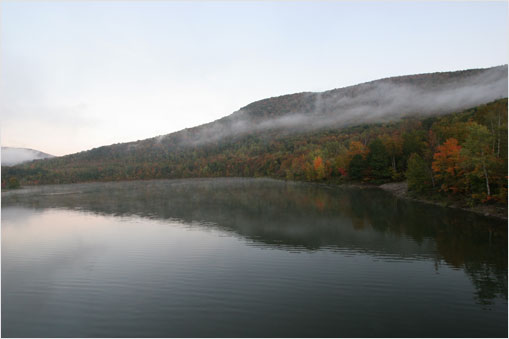 February 21, 2014 CONTACT: deppressoffice@dep.nyc.gov, (718)595-6600 Department of Environmental Protection Announces Start of Forestry Project to Remove Nearly 15,000 Storm-Damaged Trees Near Cannonsville ReservoirProject is among several forestry initiatives that will remove trees that were damaged during tropical storms Irene, Lee and Sandy and will protect public safety and drinking water qualityThe New York City Department of Environmental Protection (DEP) today announced the start of work on a forestry project that will remove nearly 15,000 damaged hardwood trees from Houck Mountain, just northeast of Cannonsville Reservoir, in Beerston, N.Y. The forest management project is one of several that began over the past year to remove trees that were toppled or damaged by powerful storms that have hit the watersheds since 2011. More than 60 percent of the trees that will be taken from the 120-acre site were blown down or broken during tropical storms Irene, Lee, and Sandy. The project will continue through 2015 and is the largest ever on water supply lands, according to records dating back more than four decades. Removing damaged trees is important to prevent forest fires. Clearing damaged trees also promotes the regeneration of the forest, which supports water quality because healthy trees prevent erosion, and serve as a natural filter by consuming nutrients that can lead to taste and smell changes in drinking water. “Removing fallen and damaged trees throughout the watersheds is a matter of public safety, water quality protection, and good management of our natural resources,” DEP Deputy Commissioner Paul Rush said. “While we move to address storm damage, DEP also realizes that it’s important to promote healthier forests that regenerate on a regular basis, maximize the use of this important natural resource, and continue to protect water quality around our reservoirs.” The work on Houck Mountain is one of seven timber projects on water supply lands that were awarded to qualified bidders in 2013. Those projects comprised 809 acres and roughly 2.7 million board feet of wood, which are also records for a single year on City-owned land in the three watersheds. The vast majority of those projects responded to damage from historically powerful storms, or sought to eliminate invasive species such as the Emerald Ash Borer. The Houck Mountain project will remove black cherry and other hardwood trees comprising more than 1 million board feet of wood. For perspective, it takes roughly 14,000 board feet of wood to frame the average single-family home. Once milled, hardwoods such as those at Houck Mountain are generally used for furniture, flooring, cabinetry, and firewood. The harvest and salvage project becomes the largest on water supply lands, according to records dating back to 1970, surpassing a 1988 harvest at Ashokan Reservoir that removed some 849,000 board feet of red pine. The seven forest management projects that were sold to qualified bidders in 2013 included six projects in the Catskills, and one project in Westchester County. Storm damage at sites near Ashokan, Rondout, Kensico, and other reservoirs comprised the majority of the nearly 2.7 million board feet that were sold. Before 2013, records show the highest number of board feet sold from water supply lands in one year was nearly 1.3 million in 2006. At each of these project sites, DEP takes extra precautions to ensure that timber harvesting does not adversely affect water quality. Forestry projects include a stormwater pollution prevention plan, and DEP staff members inspect the worksites regularly to ensure erosion controls are functioning properly. The use of heavy equipment is often suspended during heavy rain to avoid rutting and erosion. Some sites have also included silt fences, seeding, and other efforts to prevent suspended sediments from reaching the reservoirs. While recent forestry projects have focused on areas hit by storms, DEP is also aiming to harvest more standing timber across the watersheds to meet standards of good forest management, and to maximize the use and value of this important natural resource. In 2011, DEP completed its first ever comprehensive forest management plan for City-owned land in the watersheds. Under the plan, DEP inventoried forest conditions across its lands, and developed a prioritized approach to undertake forest management projects, with a goal of increasing the acres treated on an annual basis. DEP foresters have prioritized areas for future timber harvests across the watersheds by looking at forest attributes such as age, density, and overall effect on the water supply. DEP manages New York City’s water supply, providing more than one billion gallons of water each day to more than 9 million residents, including 8.3 million in New York City, and residents of Ulster, Orange, Putnam, and Westchester counties. This water comes from the Catskill, Delaware, and Croton watersheds that extend more than 125 miles from the City, and the system comprises 19 reservoirs, three controlled lakes, and numerous tunnels and aqueducts. DEP employs nearly 6,000 employees, including almost 1,000 scientists, engineers, surveyors, watershed maintainers and others professionals in the upstate watershed. In addition to its $68 million payroll and $157 million in annual taxes paid in upstate counties, DEP has invested more than $1.5 billion in watershed protection programs—including partnership organizations such as the Catskill Watershed Corporation and the Watershed Agricultural Council—that support sustainable farming practices, environmentally sensitive economic development, and local economic opportunity. In addition, DEP has a robust capital program with over $14 billion in investments planned over the next 10 years that will create up to 3,000 construction-related jobs per year. For more information, visit www.nyc.gov/dep, like us on Facebook at www.facebook.com/nycwater, or follow us on Twitter at www.twitter.com/nycwater. | ||